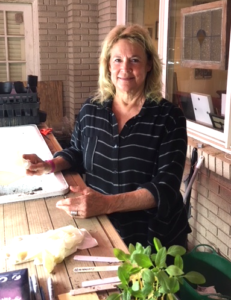 Sounding like NASA Control announcing touchdown, she shouts, “We have 100 % germination!” She beams at the miracle of it all and I can’t help but smile back, sharing her enthusiasm. Meet my friend, Honey, gardener extraordinaire and the most successful germinator I’ve ever met.
Sounding like NASA Control announcing touchdown, she shouts, “We have 100 % germination!” She beams at the miracle of it all and I can’t help but smile back, sharing her enthusiasm. Meet my friend, Honey, gardener extraordinaire and the most successful germinator I’ve ever met.
From January through April, Honey’s life is consumed with starting plants from seeds. When I visited her at her home greenhouse last week, she had nearly 3,000 seedlings in various stages of growth filling every available horizontal space.
“It all begins in January,” she explained, as we walked through the wa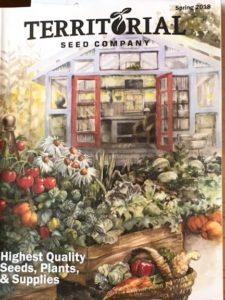 rm, misty air of her greenhouse. “When the seed catalogs come, I spend weeks deciding what to order. Every year I tell myself not to go crazy but then I get involved and lose my mind. But look at the diversity! 24 different varieties of zinnas!! And 5 different kinds of basil, including Holy Basil, one of the best pollinator plants I know of and you can only get it from seed. And look at all the different kinds of marigolds!!”
rm, misty air of her greenhouse. “When the seed catalogs come, I spend weeks deciding what to order. Every year I tell myself not to go crazy but then I get involved and lose my mind. But look at the diversity! 24 different varieties of zinnas!! And 5 different kinds of basil, including Holy Basil, one of the best pollinator plants I know of and you can only get it from seed. And look at all the different kinds of marigolds!!”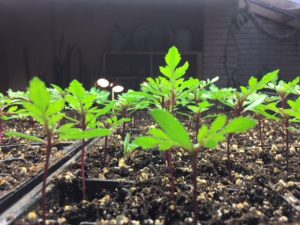
I have to stop and take a breath, still trying to grasp the idea of 24 different kinds of zinnias. But Honey doesn’t even pause. “And just look at how much you save. A package of 200- 300 seeds only costs $2.65.” And now I try to grasp the implications of spending only a penny for an annual plant, rather than $2 or $3 and my interest escalates.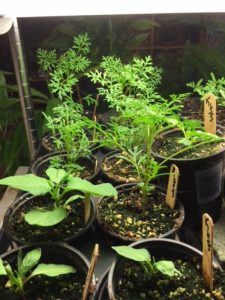
Honey’s enthusiasm is only matched by her organizational skills. As each precious package of seeds arrives in the mail, she organizes them, based on when they should be planted. The dates range from 2 – 6 weeks before the last frost date (May 1st for her garden). On a master calendar, she marks the planting date for each variety.
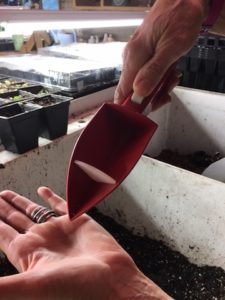
And what does Honey do with 3,000 herbs and annuals? She and her husband, Alan, take them to their “Organic Hobby Farm” in north Georgia. The summer garden is a wonder to behold. Although they plant a few vegetables, the bulk of the plants are flowers and herbs, chosen for their usefulness to pollinators. When Honey’s garden is in full bloom, it’s not only wave after wave of color, but a moving wonder of butterflies, hummingbirds and bees.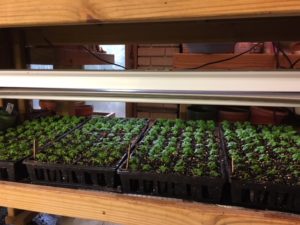
Honey’s garden, and her enthusiasm are such a gift, not only to those of us lucky enough to actually see it, but also to the thousands and thousands of native pollinators that flock to her garden, helping to create a happy, healthy earth.
Laura
For those of you interested in some of the mechanics of starting plants from seed, Honey offers the following advice:
- Order (preferably) organic seeds in January
- Divide seeds by when they need to be planted.
- Use a good seed starting mixture with plenty of vermiculate and fill flats or containers.
- Plant the seeds ( a seed applicator is an incredibly useful tool for tiny seeds) and cover with a plastic dome.
- Place the flats on heating pads, ranging in temperature from 60 – 70 degrees, based on the plant’s needs. This information is found on the seed package.
- Place cool florescent lights 6 inches from the top of the dome. Keep the lights on from 7 AM to 10 PM.
- As soon as the plants emerge, take the dome off. As the plants continue to grow, raise the lights as necessary.
- Keep the soil evenly moist, preferably by bottom watering (placing the entire flat in a shallow container of water until the soil is moist.) . Mist as necessary.
- As the seedlings continue to grow, transplant into larger containers as necessary.
